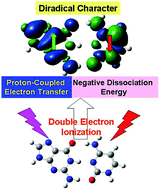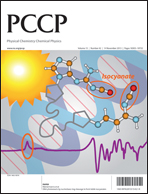Theoretical exploration of structures and electronic properties of double-electron oxidized guanine–cytosine base pairs with intriguing radical–radical interactions†
Abstract
We present a computational study of the double-electron oxidized guanine–cytosine base pair as well as its deprotonated derivatives, focusing on their structural and electronic properties. Some novel electromagnetic characteristics are found. A hydrazine-like (N–N) cross-linked structure between the G and C radical moieties is the lowest-energy one for the [GC]2+ complexes. Double-electron oxidation can considerably destabilize the GC unit and leads to a barrier-hindered dissociation channel with negative dissociation energy. This channel is governed by a balance between electrostatic repulsion and attractive hydrogen-bonding interaction co-existing between G˙+ and C˙+. The proton/electron transfer reactions in the double-electron oxidized Watson–Crick base pair occur through a proton transfer induced charge migration mechanism. For the deprotonated [GC]2+ derivative, the [G(–H+)C]+ series prefers to accompany by transfer of an electron from the G to C moiety when the G+ is deprotonated, and its highest-doubly occupied molecular orbital mainly localizes over the C moiety with a π-bonding character. For the diradical G˙+C(–H)˙ series in which the C moiety is deprotonated, the two unpaired electrons reside one on each moiety in the π system. The diradical base pairs possess open-shell broken symmetry singlet states, and their magnetic coupling interactions are controlled by both intra- and inter-molecular interactions. The double-electron oxidized Watson–Crick base pair shows strong antiferromagnetic coupling, whereas the magnetic interactions of other diradical derivatives are relatively weak. This study highlights the crucial role of H-bonding in determining the magnetic interactions.


 Please wait while we load your content...
Please wait while we load your content...